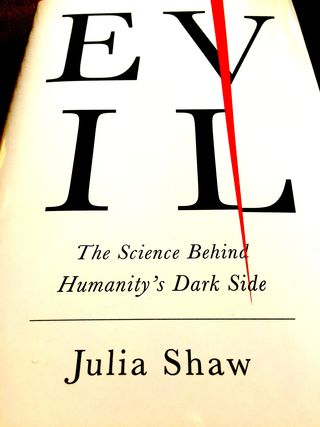Ethics and Morality
The Science of Evil
A criminal psychologist applies current research to our notions about being bad.
Posted March 10, 2019

These days, we’re exposed to two parallel types of coverage of psychopathic behavior: alarmist media hype and research rooted in decades of serious effort. The former often ignores the latter, confusing the concept. Occasionally, we get a book that bridges these areas to help us navigate both. Evil: The Science Behind Humanity’s Dark Side proposes to attune subjects like psychopathy, sadism, and evil with today’s neuroscience.
Author Julia Shaw teaches criminology and psychology at London South Bank University and is the author of The Memory Illusion: Remembering, Forgetting, and the Science of False Memory, reviewed here. Shaw’s hope for her latest book is to prompt us to think more responsibly about evil. She “ranges across a spectrum of concepts and notions that are often associated with the word,” without venturing too much into religion or philosophy. Instead, she wants us to understand things about our brain that clarify why we harm one another (and why these acts fascinate us).
She takes Hitler – a figure known universally as monstrously evil and shows how his trajectory toward atrocity could occur through a mix of brain activities and cultural events. Going over the primary brain parts involved in feeling and decision-making during the process of dehumanizing and justifying harm, Shaw unpacks who he might have been. Perhaps Hitler had an underactive ventromedial prefrontal cortex, which is implicated in defective moral judgments. Add paranoia, reinforced by an anxious culture seeking direction, and you have the makings of what we now consider a monster.
What’s a book about evil without a discussion of the "dark triad"? Shaw takes on psychopathy, narcissism, and Machiavellianism, and adds sadism. After looking at research on psychopathy and its empathy deficits, she discusses two kinds of narcissism: The grandiose narcissists are convinced of their own superiority, but the vulnerable narcissists are fearful and defensive. This makes them more dangerous in terms of rage, hostility and “angry rumination.” Under the right conditions, they will act out.
Shaw describes current research about aggression to present “everyday sadism,” with the conclusion that “there is no such thing as an evil brain, an evil personality or an evil trait… ultimately, we find ourselves knee-deep in complicated and nuanced aspects of humanity.” Hitler was not as different from the rest of us as we'd like him to be, she says.
And all of this is just in the first chapter!
Evil covers a wide range of subjects, from the creepiness of clowns and collectors to sexual deviance to the dark side of tech. Shaw undermines long-held beliefs about the universality of moral judgments for certain acts with more recent research, such as the supposed connection between testosterone and aggression. Her primary theme is that the concepts of violence and evil are much more complex than we realize, and before we judge we must always consider the context.
Shaw delves into all manner of deviance to show that moral labels and emotional reactions derive from our respective cultures. But that’s just basic moral relativism. There’s nothing new in this perspective. The real impact of the book comes from the research. Are bystanders really as passive as the famous Kitty Genovese case would have us believe? Are people actually inclined to harm others if an authority figure orders them to? How many people would actually kill one person to save multiple others? Are people who watch violent pornography more likely to be aggressive? Are murder fantasies normal?
Examining the science involved in these subjects brings a new perspective, although the neuroscience was more compelling than some of the social science analysis, especially when Shaw relied on older research. I was surprised that she recognized the criticism that Zimbardo’s Stanford Prison Experiment had recently sustained without exploring whether it has undermined his claims. The replication crisis has also skewered other studies that Shaw uses. Ironically, her argument about contextual influence on moral judgments works equally well on psychological interpretations of human behavior. This point deserved some attention.
But that’s just a blip in an otherwise provocative and wide-ranging book. Shaw wants to “tear away the preconceived notions of evil and the vast amount of misinformation that is routinely fed to us.” She seeks to “personalize evil” and encourage us to think about what we might do in certain situations. Thus, this book will shock some readers with its willingness to humanize individuals who’ve behaved in seemingly despicable ways. We’re challenged to consider scenarios about things like rape, torture, complicity with atrocity, and sex with kids and animals.
So, those acts that we call evil are part of the human experience. Shaw hopes to use a more sophisticated understanding to help fight urges to do harm. She offers a list of ten points that should hinder us from participating in dehumanization and asks that we all stop calling specific people, events, and behaviors evil. Only by rethinking this concept, she says, can we take effective steps to decrease its destructive impact.
References
Shaw, J. (2019). Evil: The science behind humanity's dark side. New York, NY: Abrams Press.




